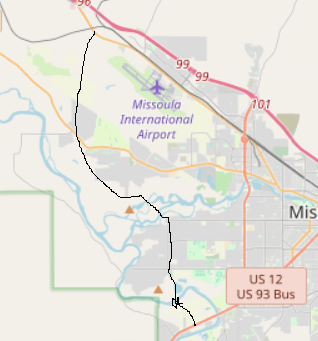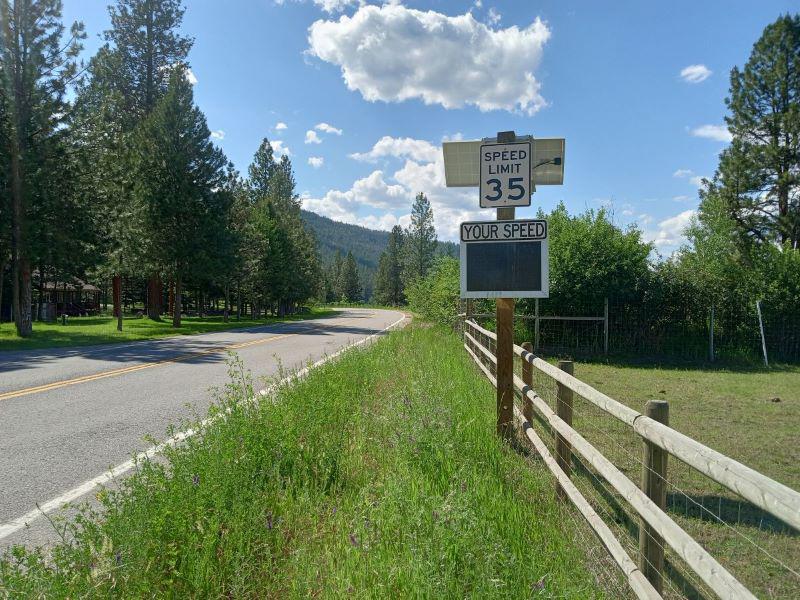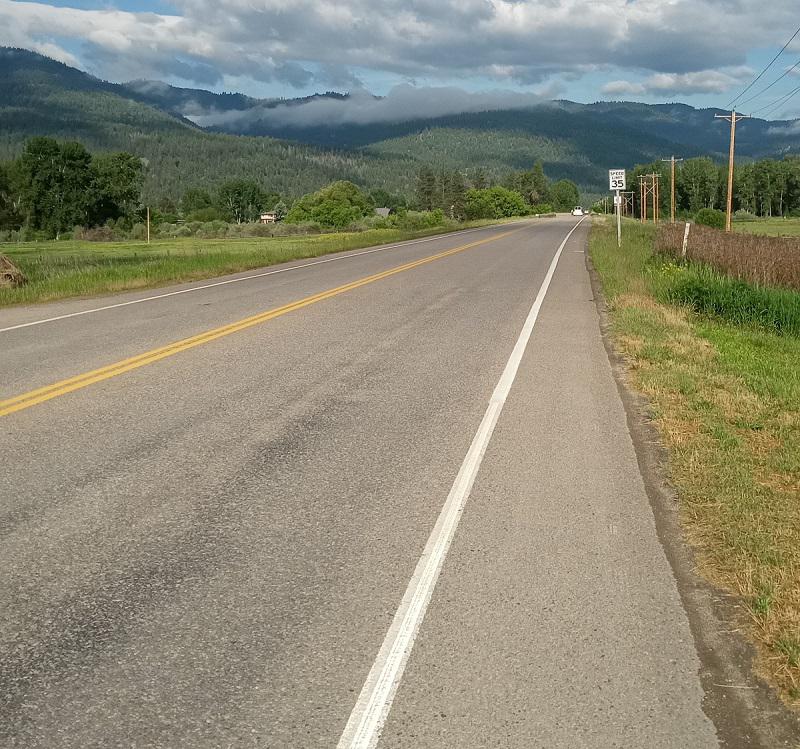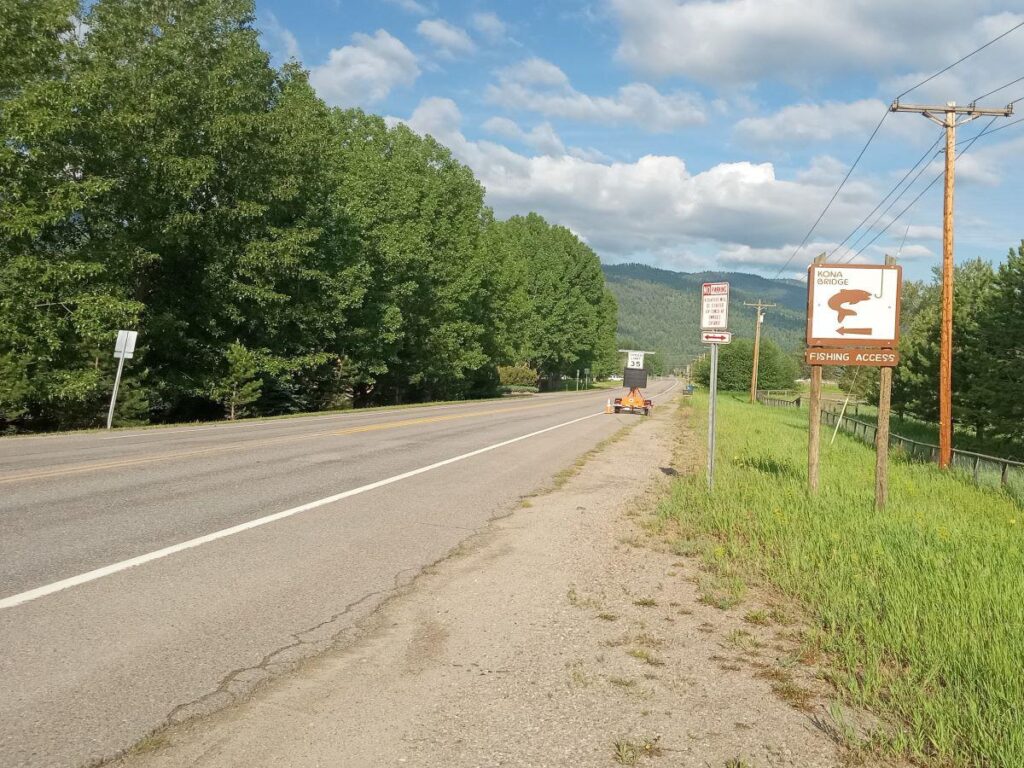Blue Mountain Road, from Highway 93 just south of Missoula to its meeting with Big Flat Road and North Avenue west of the Bitterroot River is a narrow, twisting, slow-motion drive. While some of the scenery might be considered worthwhile, much of it is nothing more than drab hillside, empty fields, or gaudy residential palaces which seem out of place in the remoteness. There are numerous sharp corners which can be taken safely only at speeds of less than 20 mph and, even then, one must be acutely aware of traffic approaching in the opposite direction which might be traveling just a little too fast, crowding the center line just a little too aggressively.
This road has been bruited about, not seriously, as an alternative route to the traffic congestion coming into Missoula from the south every weekday morning. Theoretically, this “bypass” would tie into an extension of South Avenue which would include a new bridge over the river and divert some of the traffic from the Bitterroot as people commute to their workplaces in the city. However, to anyone who has driven over this route, as I have many times in the last year, it is evident that trying to shoehorn the road into a major artery would require a complete gutting and rebuilding of the road itself, which is simply not reasonably nor economically plausible.
There are three major hindrances to this, none of which can be easily overcome:
- The Bitterroot River, which has flowed in place for who knows how long and is not likely to change course simply because someone thought it should, and,
- The irrigation canal which wraps around the slopes, closely paralleling the road itself. Legally, it would be almost impossible to remove, reroute, or do away with the canal. It, like the river, is an insurmountable obstacle, and due to the narrowness of the area, would eliminate any possibility of widening the road to any discernible degree, and,
- The mountainous terrain. Too costly to cut for the benefit received.
Blue Mountain Road, as it is, is likely to remain that way for a long, long time and I am at peace with that.
Let’s Be Realistic About All This
Any bypass which had a possibility of easing the traffic congestion on Highway 93 into south Missoula would be built on the flat plain, passing north of Macauley Butte and would connect to South Avenue just west of Clements Road. North Avenue, Spurgin Road, and Third Street W. could easily be tied into it. From Third Street, the highway would turn northwest, bridge the Clark Fork River, wrap around Council Hill, connecting with Mullan Road west of the 44 Ranch development, and eventually meet Broadway west of the airport. This route could work and, if it ever looked like it might be put into effect, would engender a huge amount of resistance from the NIMBY (Not In My Back Yard) folks.

However, I’m not trying to engineer an easier, more logical, sane, and sensible route around the mess which is the street plan of Missoula. That’s above my pay grade. Instead, I’ve got a more personal gripe to air—ridiculous speed limits on Big Flat and Kona Ranch roads.
Slow Down! You Move too Fast!
Blue Mountain Road, as previously mentioned, ends where it meets Big Flat Road and North Avenue. Since the North Avenue bridge over the river was closed, there is virtually no other choice but to go up the hill onto Big Flat Road, which is not substantially different in character from Blue Mountain, except that it has more vertical lift (steep slopes) and many of these slopes have absolutely no protection (guard rails) to protect traffic from plunging over the edge. Random trees provide the only barrier to a long descent downward, potentially into the river at the bottom. If I wanted to commit suicide (I don’t), driving off the road at a high rate of speed would be one way to do it. All it would take is a flick of the wrist at the appropriate moment.
I have no complaint about the lack of guard rails, because I remember my father’s viewpoint on matters like this, roughly paraphrased: “Don’t blame someone else because you weren’t paying attention to your situation.” For those who are aware of the conditions and drive appropriately, the eastern half of Big Flat Road is not particularly dangerous. It just needs to be treated with respect.
I am bothered, however, by one thing which does not become evident until you crest the top and drop down the western side of the hill into what is truly Big Flat—a digital sign which displays The Law, reads your vehicle speed, and flashes you a signal if it determines that you are driving over the designated limit. “Slow down! Slow down!!” If it had a voice, it would scream at you.

I hate nags, especially those which are impersonal and have nothing to do except to remind me that I am doing something which is prohibited. When I descend the hill and see this message, shrieking at me with its “Nanny State” demeanor, I deliberately step on the gas pedal, unlike those who reactively hit the brakes and do as they are instructed. But that’s just me. I’ve never been good at slavish obedience.
The fact of the matter is that, except for a few right-angle turns in the road, the western side of Big Flat Road can handle speeds up to 45 mph without any trouble. There is no good reason for demanding that vehicle speeds be restricted to 35 mph. This is quite simply an exercise in ridiculosity.
But Wait, There’s More!
It gets worse. Eventually, Big Flat Road comes to an end at Kona Ranch Road, which connects with Mullan Road to the north. From here drivers can go east to Missoula or west to the Wye and Interstate 90, albeit through a tortuous system of low-grade dirt tracks.

Kona Ranch Road is a wide, relatively straight, flat highway where there are no hairpin turns, no dangerous intersections, no steep slopes rising from or plunging into. In fact, at one point on the road (above photo), it is quite possible to see half a mile or so into the distance, eliminating any possible “blind” spots. Kona Ranch has wide, well-maintained lanes, good shoulders, and is quite capable of carrying traffic at the rate of 55 or 60 mph without any problems. Yet, the same limit applies as on Big Flat. There is even a Sister Nag, silently and incessantly reminding drivers that they are going too fast, above the arbitrary and capricious limit. In addition, there are no passing lanes so if you’re behind someone who is “legal”, you’re stuck there—unless you break the law by crossing the double yellow line. Unrealistic. Insane. Idiotic.

“Slow down! You move too fast!” One does not have to be familiar with Simon & Garfunkel to appreciate the incongruity.
Compare this stretch of road with Eastside Highway in Ravalli County from Florence to Stevensville, a heavily travelled highway which has many times the traffic as Kona Ranch. In some places, Eastside has steep drop-offs without guard rails. There are curves, hills, and many side roads. The shoulders are narrower, often with grass growing nearly up against the travel lane. Yet, Eastside Highway has a speed limit of 60 mph and it is a provable fact that anyone driving at a “sedate” speed of “only” 50 mph will have a long line of traffic backed up behind them.
I can understand and have no problem with lower speed limits where they are necessary and rational, e.g., a residential neighborhood where density is the norm and the houses are close to the highway, but this does not apply to Kona Ranch. The houses, often elegant and sometimes ostentatious, are widely spaced and set back well away from the highway. There are no crosswalks. There is very little pedestrian movement and few bicyclists. There are no schools, no sidewalks, no children playing hopscotch on the sidewalks. Why, then, is there such a pronounced insistence on keeping speeds so low? One reason which comes immediately to my suspicious mind is that someone who has considerable influence is using it to make life miserable for everyone else. More than likely, that person lives in one of the elegant and ostentatious houses on Kona Ranch Road and simply wants to control the situation. For one reason or another. Because he can. Or she can. However, this is only speculation and should be seen as such.
Why does Traffic Control go along with this. God and the perpetrators know. I am only able to guess, but there is one easily understood answer which explains it all, and it has to do with, you know, the thing that makes the world go around—money. It is entirely possible that Kona Ranch Road has such low-speed limits so that a zealous cop, eager to make an impression on his superiors or because he is an obnoxious jerk, can write tickets to “enhance revenue.” In other words, bolster government coffers by making criminals out of people who have done nothing wrong but have transgressed the “red-line of acceptable behavior”—that is to say, driving faster than they are officially allowed.
Am I right? Am I wrong? The case could be made for either. I’m not an investigative reporter, digging deep into the murky, muddy mess of local governance, yet I believe that, in this instance at least, “officialdom” has its head screwed on backwards and the Status Quo needs to be changed.
“One foot on the brake and one on the gas,
Scared to death, I won’t pass.
The road ahead is arrow straight,
To drive like a wuss seems to be my fate.”
Sammy Hagar had it right. I CAN’T DRIVE 35!
“Of all tyrannies, a tyranny sincerely exercised for the good of its victims may be the most oppressive. It would be better to live under robber barons than under omnipotent moral busybodies. The robber baron’s cruelty may sometimes sleep, his cupidity may at some point be satiated; but those who torment us for our own good will torment us without end for they do so with the approval of their own conscience. They may be more likely to go to Heaven yet at the same time likelier to make a Hell of earth. This very kindness stings with intolerable insult. To be “cured” against one’s will and cured of states which we may not regard as disease is to be put on a level of those who have not yet reached the age of reason or those who never will; to be classed with infants, imbeciles, and domestic animals.”
CS Lewis




I have lived in Missoula for about five years and have experienced the ridiculousness of the city government’s control of the roads. It feels like their ideal scheme would be to make every intersection within city limits a four-way stop (I hesitate mentioning that in fear that they would seriously consider it). I have not driven much on Highway 93 between Missoula and Hamilton but have heard numerous accounts of the dangers in turning onto that road. Perhaps what is needed is an exchange. Trade the Missoula city traffic controllers with the ones in charge of south Highway 93. Then there might be additional safety measures put in place on Highway 93 and Missoula city roads could be more functional.
I should mention that shortly after I submitted this to Western Montana News, the North Avenue bridge was reopened (which greatly reduces my commute time when I am working on that side of the river) and the “sister nag” on Kona Ranch Rd. was removed. However, the speed limit was not changed and remains at 35 mph.
So you still cant drive 55?
I have a car in which the speedometer is messed up. It registers 140 sitting still. If a cop stopped me and asked if I knew how fast I was going, I would be able to tell him honestly that I did not.